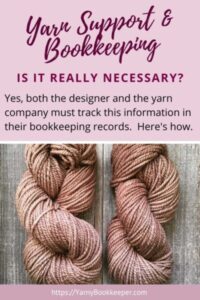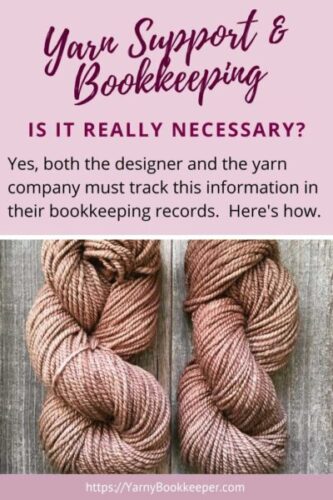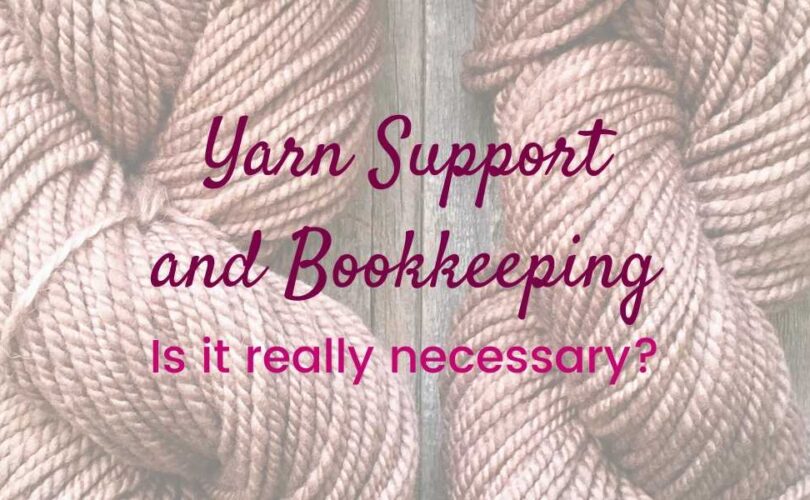Yarn support and bookkeeping – is it really necessary?
Yarn support is when a yarn company gives a designer free yarn to use in a knitting or crochet pattern design. Some people will argue that the yarn isn’t a gift to the designer, but rather a collaboration for both parties – with benefits.
While I agree that it is a collaboration with benefits for both the designer and the yarn company, each of them must track this information in their bookkeeping & accounting records.
What really occurs here is that you have just entered into what is called bartering. Bartering occurs when two or more parties exchange goods or services without the use of money.
I must confess, when I was first asked to write about this topic, my initial reaction was that the yarn would go into inventory with a zero cost (because you didn’t pay for it) but that you would keep track of the retail cost in whatever you would use for tracking the cost associated with the overall design process, determine your pricing, and determining your break even point. Then it was like, No – that’s not right – this is a barter transaction and I dug out my accounting books. And I can’t believe I forgot about having to account for barter exchanges!

When you barter for other goods and services, you are still investing time and resources to sell the item you are trading. Not accounting for barter transactions is like not doing any bookkeeping at all for your creative biz.
Recording yarn support transactions is fairly simple if you break it down into individual pieces.
When you barter, two transactions occur:
- you sell something
- and you buy something
The MOST confusing part can be determining the value of the transaction.
IRS guidelines are quite specific. (As a designer) You must value the transaction at the fair market value of the item you are receiving. In most cases, the fair market value is already know – it’s the normal sale price (or cost) of the item.
So, the sale or your goods or services (your pattern design) is valued at the purchase price of the goods you are receiving.
BUT, you also have to record the receipt of the item.
Sample barter exchange for yarn support:
As a designer you are trading your finished pattern or design for 4 skeins of yarn from Yarn Company X. The yarn normally retails for $8.99 per skein ($35.96 in total).
How a designer would enter yarn support in their bookkeeping system.
There are several ways that this transaction could be entered, it depends on how you’ve set up your bookkeeping system. The following workflow is simply a suggestion.
The easiest way to account for yarn support is to set up a “bank” account in your bookkeeping system called Yarn Support/Barter Exchanges.
If you’re using QuickBooks, you would literally go into your Chart of Accounts and create a new Bank type account. If you use spreadsheets, you would create a new spreadsheet “Bank account” for Yarn Support/Barter Exchanges.
Recording the receipt of the yarn
The first thing you do when you receive the yarn from the yarn company, is you open that Bank Account in QuickBooks and write a check for $35.96 to the yarn company and post it either directly to your Cost of Goods Sold Materials account – or you can put it to Inventory – the choice is yours. (This gives you a negative balance in that account).
NOTE: This yarn does not have to go into Inventory, because you just can’t accept the yarn and then tell yourself you’ll get to the design when you feel like it. You’ve committed yourself to producing the pattern according to the timeline you gave the yarn company.
Recording the sale of the finished pattern
When the design is finished you then need to record the sale of the finished pattern to the yarn company.
In your Customer Center in QuickBooks, you’d create a customer called Company X-Yarn Support. From your Item List, you’d create an Item for Pattern Name X with a price of whatever you would normally sell the pattern for, pointed to your Pattern Income account. You would then create an invoice for the pattern and change the value of the sale price to $35.96. You would then receive a Payment of $35.96 and deposit it to the Yarn Support/Barter Exchanges bank account. That account now has a $0.00 balance.
Recording barter transactions using spreadsheets
Again, everyone has a different spreadsheet system setup, so it’s impossible to provide specific details. The following is simply an overview of the workflow.
If you use a spreadsheet, you go to that newly created sheet, and record the purchase of the yarn from the yarn company and again post it directly to your Cost of Goods Sold Materials Account as a negative – or post it to Inventory. Then you go to the sheet that tracks your Cost of Goods Sold Materials or to your inventory sheet, and record it as a positive .
When you finish the design and you’re ready to record the “sale” of the pattern. You would
- remove the yarn from your Inventory Sheet as a negative,
- record the $35.96 in the Cost of Goods Sold Materials spreadsheet as a positive
- enter the $35.96 as a positive on the Yarn Support/Barter Exchanges sheet
- Record the $35.96 on your Income Spreadsheet in a new column called Barter Income
While receiving yarn support as a knit or crochet designer reduces your outlay of cash when designing new patterns, tracking that information in your bookkeeping records can be cumbersome and confusing.
I hope this article was helpful. Please let me know what you think.



